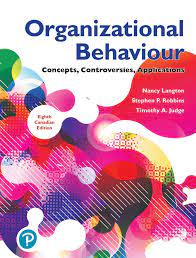ORGANIZATIONAL BEHAVIOUR: CONCEPTS, CONTROVERSIES, APPLICATIONS 8TH CANADIAN EDITION LANGTON – SOLUTION MANUAL
In Stock
Original price was: $55.00.$50.00Current price is: $50.00.
ORGANIZATIONAL BEHAVIOUR: CONCEPTS, CONTROVERSIES, APPLICATIONS 8TH CANADIAN EDITION LANGTON – SOLUTION MANUAL
Table of ContentsPart 1 Understanding the WorkplaceChapter 1 What Is Organizational Behaviour?Chapter 2 Perception, Personality, and EmotionsChapter 3 Values, Attitudes, and Diversity in the WorkplaceOB ON THE EDGE Stress at WorkPart 2 Striving for PerformanceChapter 4 Theories of MotivationChapter 5 Motivation in ActionChapter 6 Groups and TeamworkOB ON THE EDGE TrustPart 3 Interacting EffectivelyChapter 7 CommunicationChapter 8 Power and PoliticsChapter 9 Conflict and NegotiationOB ON THE EDGE Workplace BullyingPart 4 Sharing the Organizational VisionChapter 10 Organizational CultureChapter 11 LeadershipChapter 12 Decision Making, Creativity, and EthicsOB ON THE EDGE Spirituality in the WorkplacePart 5 Reorganizing the WorkplaceChapter 13 Organizational StructureChapter 14 Organizational Change
Introduction
“Organizational Behaviour: Concepts, Controversies, Applications, 8th Canadian Edition” by Langton is a key resource for understanding the dynamics within organizations. The solution manual accompanying this textbook is an invaluable tool for both instructors and students, providing detailed solutions to the exercises and case studies presented in the book. It aids in reinforcing concepts, clarifying controversies, and applying theoretical knowledge to practical scenarios.
Overview of the Book
The 8th Canadian Edition of “Organizational Behaviour” by Langton offers a thorough exploration of the fundamental principles and current issues in organizational behaviour. It integrates Canadian examples and research, making the content highly relevant to students in Canada.
Key topics include:
- Introduction to Organizational Behaviour
- Individual Behaviour and Learning
- Motivation Concepts and Applications
- Group Behaviour and Work Teams
- Leadership Theories and Styles
- Communication in Organizations
- Organizational Culture and Change
- Conflict, Negotiation, and Intergroup Behaviour
Importance of the Solution Manual
The solution manual for “Organizational Behaviour: Concepts, Controversies, Applications, 8th Canadian Edition” is essential for mastering the material. It provides comprehensive answers and explanations for all the exercises, end-of-chapter questions, and case studies found in the textbook.
Benefits of the Solution Manual:
- Enhanced Understanding: Detailed solutions help students grasp complex concepts and theories.
- Study Aid: It serves as a valuable resource for students when studying for exams or completing assignments.
- Instructor Support: Instructors can use the solution manual to facilitate classroom discussions, develop teaching strategies, and assess student performance.
- Application of Knowledge: The manual helps students apply theoretical knowledge to practical situations, reinforcing learning through real-world examples.
Key Features of the Solution Manual
1. Comprehensive Solutions: The manual provides detailed solutions to all exercises, questions, and case studies, ensuring that students understand the steps and reasoning behind each answer.
2. Clear Explanations: Solutions are explained in a clear and concise manner, making complex concepts easier to understand and apply.
3. Practical Applications: The manual emphasizes the application of organizational behaviour concepts to real-world scenarios, helping students see the relevance of their studies.
4. Alignment with Textbook: The solution manual is closely aligned with the textbook, ensuring consistency and coherence in the learning process.
Sample Content from the Solution Manual
Chapter Exercise Solution: Chapter 3: Motivation Concepts and Applications
- Describe the main components of expectancy theory and explain how they influence employee motivation. Solution:
- Expectancy: The belief that effort will lead to performance. If employees believe their effort will result in successful performance, they are more likely to be motivated.
- Instrumentality: The belief that performance will lead to desired outcomes. Employees need to see a clear link between their performance and the rewards they receive.
- Valence: The value an individual places on the rewards. If the rewards are attractive and meaningful to employees, their motivation levels will increase.
Case Study Solution: Case Study: Leadership Styles at XYZ Corporation 2. Analyze the leadership styles presented in the case study and discuss their impact on employee performance and organizational culture. Solution:
- The case study presents two contrasting leadership styles: autocratic and transformational.
- The autocratic leader focuses on control and decision-making power, which can lead to low employee morale and high turnover.
- The transformational leader emphasizes employee empowerment, motivation, and development, fostering a positive organizational culture and high performance.
- The impact on employee performance is significant, with transformational leadership leading to higher job satisfaction, commitment, and productivity.
End-of-Chapter Question Solution: Chapter 5: Group Behaviour and Work Teams 3. Explain how group norms and cohesiveness influence group performance. Solution:
- Group Norms: These are the shared expectations and rules that guide behaviour within a group. Strong norms can enhance performance by promoting predictability and reducing conflicts.
- Cohesiveness: This refers to the degree to which group members are attracted to each other and motivated to stay in the group. High cohesiveness can lead to better communication, increased satisfaction, and improved performance. However, if cohesiveness is too high, it may lead to groupthink and reduced critical evaluation of decisions.
Conclusion
The solution manual for “Organizational Behaviour: Concepts, Controversies, Applications, 8th Canadian Edition” by Langton is a crucial resource for both students and instructors. It enhances the learning experience by providing detailed solutions, clarifying complex concepts, and applying theoretical knowledge to practical scenarios. By utilizing this solution manual, students can achieve a deeper understanding of organizational behaviour and be better prepared for academic and professional success.


Reviews
There are no reviews yet.